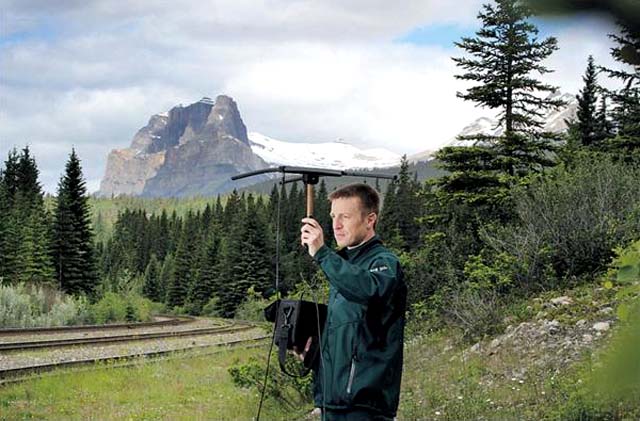
2012
|


Steve Michel, a human-wildlife conflict specialist with Banff National Park, looks for signs of grizzly bears near the
train tracks in the park - Date unknown Leah Hennel.
7 July 2012
GPS Collars Will Help Keep Banff Bears Off Train Tracks
Banff Alberta - The GPS signals show No. 64 and No. 130, both female grizzly bears, wandering around the Bow Valley with five yearling
cubs.
No. 122, a 220-kilogram male grizzly, has been covering a lot of ground, from the edge of Canmore to Kootenay Park, on the hunt for a girlfriend during this
year's breeding season, which is wrapping up.
With the snow melting, the newly collared bears will all head higher up into the mountains until the summer berry season begins.
For the next couple of weeks, Steve Michel hopes to rest a little easier knowing there's less chance of an encounter between a grizzly and a train on the
railway tracks, the cause of 11 deaths in Banff National Park and two just outside its boundary since 2000. Another eight grizzly bears died on the
Trans-Canada Highway during the same period.
"It's particularly a problem for the female grizzly bears, which was really concerning for us because they are obviously critical to the population,"
says Michel, a human-wildlife conflict specialist with Parks Canada.
However, there's now another way for parks staff to keep an eye on some of the park's 60 beloved bears throughout the year.
Michel and a team of Parks Canada staff have spent the past six weeks capturing and fitting 11 grizzly bears with GPS collars so they can be monitored to
prevent future deaths on the railway tracks.
The $1-million initiative, which includes several other research projects, is part of a five-year partnership with Canadian Pacific Railway that was launched
in fall 2010.
"What is most exciting from CP's perspective is that there are a lot of people who have scientific backgrounds," said Breanne Feigel, a CP
spokeswoman. "We are getting the best of the best together."
Teams of internationally recognized experts in the areas of conservation biology, animal behaviour, transportation research, and bear biology are looking at
vegetation management along the tracks, a grain aversion program, and overall bear behaviour.
Environmentalists say they're hopeful about the work being done to protect grizzly bears in the park.
"There is definitely evidence of Parks Canada and CP investing significant resources," says Sarah Elmeligi, senior conservation planner with the
southern Alberta chapter of the Canadian Parks and Wilderness Society. "It's going to take a few years to solve some of these problems."
"Hopefully we'll get some solutions that will prevent bears from being schmucked by trains," said Elmeligi.
Kris McCleary, science adviser for mountain parks with Parks Canada, says the research will not only be used, but shared widely.
"We're at the cutting edge, we're breaking new ground," says Mc-Cleary, who is the project manager for the bear/train collision initiative.
"We're going to have a really good picture of bear/train collisions."
The research includes a graduate student reviewing videos to evaluate a bear's behaviour right before it was killed on the tracks.
Other experts are introducing a substance that will induce an aversion to any grain spillage from the train cars, while another is tracking animal movements.
The collaring project, which will help gather detailed data on the bear's movements, is a key component of the plan. Since May, 11 grizzly bears, including six
females with offspring, have been fitted with GPS collars, two have ear-tag transmitters, three were captured and released without tagging because they were
not target animals.
Michel says it took less than two hours to fit the bears with the collars once they were trapped in a culvert or darted at free range.
The GPS collars record the bear's location every two hours.
"If we know they are in an area, like a Canadian Pacific corridor in particular, we can crank it up to every 20 minutes to get that more fine-scale
data," says Michel, noting they then notify the company about the bear along the tracks. Similarly, the train crews report bear sightings to Parks Canada.
On Wednesday morning, Michel looks up the GPS signal of No. 64, a 23-year old female grizzly dubbed the matriarch of the Bow Valley, and her three yearling
cubs, and finds her in the Bow Valley near the Trans-Canada Highway.
"She is a real success story," he says of No. 64, who's expected to have one more set of cubs in her lifetime. "Hopefully she'll continue to
survive in the Bow Valley long enough to be able to do that."
Unfortunately, her cubs have not been so fortunate.
"We're not aware that she has any surviving offspring at all," says Michel, noting she has a litter of three yearling cubs with her right now.
She had another litter of three cubs in 2006 and one died from unknown causes in the first year. The other two stayed with their mother until they were almost
four years old.
"Both of those animals died on the transportation corridor," he says of the bears, who were tagged with radio collars 108 and 109 because they were
spending lots of time close to the Banff town site. "In 2010, grizzly bear 109 died on the railway tracks and in 2011, last year, grizzly bear 108 died on
the Trans-Canada Highway."
As he drives along in search of No. 64, a small ping can be heard from the radio transmitter.
"It could mean we are starting to get closer to where she is out here, or she could be up a side drainage, and that's all we're going to get is a little
peep," he says.
No other sounds are heard. However, the younger No. 130 is also in the area with her two year-ling cubs.
When Michel switches the frequency on the radio transmitter, he's able to track her to an area called Hillsdale Meadow, along the Bow Valley Parkway. The pings
get louder and faster as he drives closer to the site. In the meadow, it becomes a steady beep, beep, beep.
"She might be quite close," says Michel, as he uses old-fashioned radio telemetry to try to get a precise location on the bear and her yearling cubs.
"I don't think she's too far away. I bet she's on the far end of that meadow."
"We're not going to walk out there, that's for sure. It is a grizzly bear with two yearlings."
He explains No. 130 is slightly more wary than No. 64. "If she was around, she would just be feeding out in the open. Nothing really bothers her," he
says. "This bear is a lot more wary. She still likes to use these areas of high-people use, but she likes to keep her head down."
He continues to walk around the open meadow with the receiver.
"She's within 150 metres, probably at the most right now. She's just tucked on the far side of that meadow," says Michel, as he tries to pinpoint No.
130's location without getting too close. "You can see the railway tracks just through there."
"There's not a lot of grain along the railway tracks right now. Hopefully that's not what she's up to."
Colette Derworiz.


 This web site was assembled on Vancouver Island in British Columbia Canada. This web site was assembled on Vancouver Island in British Columbia Canada.
|

